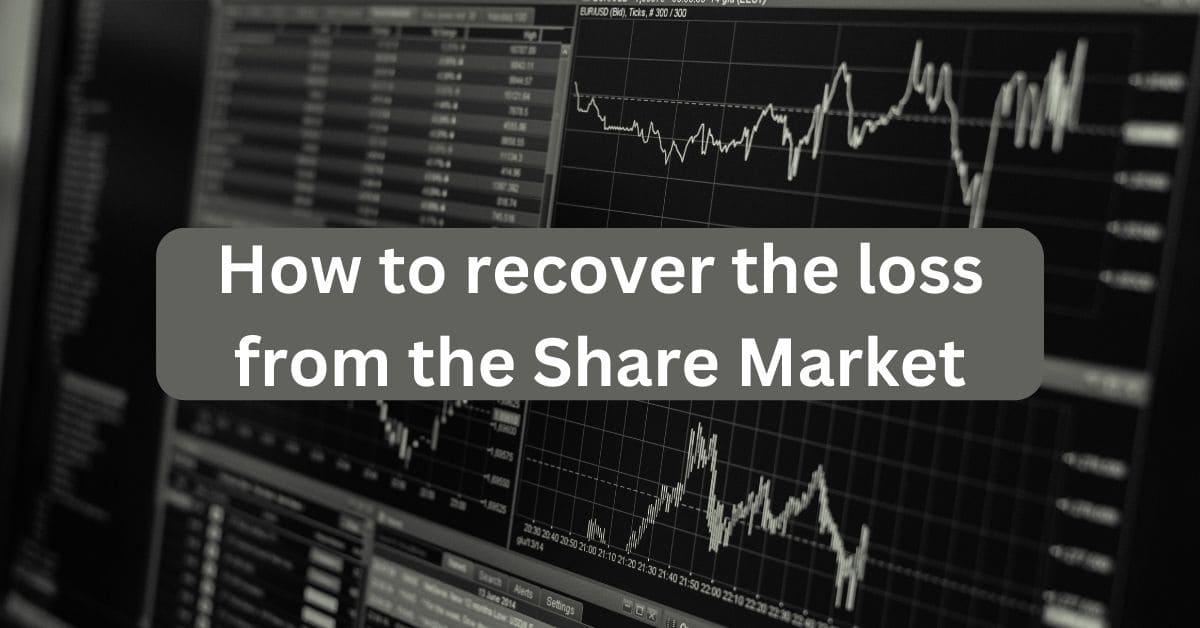- How to recover the loss in the share market
- Recover the loss in intraday trading
- How to recover share market loss
If you are searching for anything from the below then this article will be your last search because we are going to look at every possible method to recover all your losses.
This article gives you the right direction and secrets to recover the loss from the share market.
No bluff, everything will be practical and on the basis of truth. Let us start the article.
How to recover the loss in the share market
Many of us trade in the stock market, but due to a lack of knowledge and experience usually make mistakes and face huge losses. But with the proper guidance, one can actually understand their mistakes and learn from them. Which results in profits.
For your situation, this article will be your perfect guide to take away from all your losses. We will be looking for each of the aspects and points which will be responsible for your profit in the future.
You should read these whole points carefully and implement them in your trading.


Change your perspective
If you really wanted to recover your money from the stock market, then you should have a different perspective on the market.
When you lose money, you must admit that it happened due to your mistake only. You should not blame others, not even the market. Because the market is supreme. It works just as it would.
If you are having a negative image of the market, you will never recover your money.
You should be actively smart here while trading or investing in the share market.
Recovery of your money only is possible when you are looking at the market with a positive, optimistic perspective view.
You should believe in yourself, your mentor, and the strategies you are implementing. Also, you should believe in the process. Though it is time-consuming. But beliefs only save you.
Believe that you can recover share market loss. You should always think about how to recover the loss in the share market you did, either by delivery trading or intraday trading.
Perspective plays a vital role to recover the loss in the share market.


Journalize everything
In order to repair your mistakes and overcome them, the very first step for you is to journalize them.
Journalizing will create a basis and track record of all your activities.
You can write your positions, your achievements in terms of learning, and the profits you got through it.
This is the most accepted method by most investors and traders.
Following things, you can write in your trading journal.
- Your daily new learnings about the market
- Your research and studies
- Mistakes and learnings you did for a particular trade
- Important Quotes and rules for trading
You can journalize it in the traditional pen and paper method or modern digital methods over multiple tools.
- Microsoft’s OneNote
- Word Editor (Google Docs, MS Word, LibreOffice Writer, OnlyOFFICE, etc.)
- Spreadsheet (Google Sheets, MS Excel, OnlyOFFICE, etc.)
Journalizing trading activities help you to recover the loss in the share market.


Framing perfect strategy
Know your personality
No person is the same as others. Everyone has a different identity. Each one has a different skill set which can be beneficial while trading.
If any strategy is good for any person, that might not be good for everybody.
Because personality plays an important role in trading. But unfortunately, most people do not know what is their personality and fail to find a suitable strategy. Here is some brief idea you can get related to personality.
Personality on Decision-Making Style
- Charismatic – Only focus on final profits and jumps into trades
- Thinker – Check each data point, Quality, Proof, etc.
- Skeptic – Do not believe easily, check the validity and authenticity of each fact
- Follower – Relies on others’ opinions, if any strategy works with others, they start implementing it on themselves.
- Controller – Try to create their own strategy, referring to other’s methods, they like to rely on their methods no matter how much profitable strategy others having
Personality on Pace of Decision
- Quick Thinker – Do not think much to take decisions. Prefers speed decisions over accuracy. (Best strategy – Intraday, F&O)
- Deep Thinker – Never make haste to come to conclusion. Prefer accuracy, authenticity, and validity over speed. (Best strategy – Value investing)
Each personality has some advantages and disadvantages as well. But in the stock market, you can have any type of strategy as per your personality.
There is another factor other than personality, which is your availability for the market. Read further to know more.
Availability for the market
Not only personality, but your availability for the market also matters more while making your trading strategy.
If you are usually busy with your business, job, household work, or studies, then you might not be able to focus on the market. Then you have to prefigure what kind of strategy you should choose.
Do not come under influence of others who try to convince trading at your odd time. Keep in mind that they are convincing you of their benefits. You should respect each second, each minute, and hour.
You should have control over where to spend it.
Keep in mind that, every person can trade with his own personality and style of trading.
Even though you are having less time to be available in the stock market, you can still able to recover all your stock market loss from the market itself.


Choose your segment wisely
Selecting segments plays an important role while trading or investing. Because segment is the base for creating strategies.
Which segment you trade, will define your risk appetite and the way you trade or invest.
Here is a simple guide to follow before selecting a segment.
- Equity – Short or Long term investing (Beginners can use for intraday with low quantity)
- Options Selling – Trading and Business purpose
- Options Buying – Hedging purpose or if expecting a big move on either side.
- Futures – Short-term trading purpose (Instead of buying equity shares)
This is a very small guide, but this may give you a little idea about selecting a segment.
Every segment is profitable, which is sufficient to recover the loss in the share market. But you should have such trading strategy which solves your question “how to recover the loss in the share market”


Grow your knowledge
If you are really a beginner in the stock market then it is highly recommended to read blogs, useful trading books, or watch useful videos. The following links will be helpful for learning stock market and growing its knowledge. By reading others’ experiences, you can learn a lot.
- How to learn stock market investing?
- Books for Stock Market investing.
- Best all-time books for Business.
- Top YouTube channels for Stock Market trading and options trading as well.


Consistency is the king
As of now, you might have understood that there is no strategy that can give you profit on every trade. Each strategy has some limitations, we have to accept (admit) them.
But rather than changing strategy every time, we should stick to one strategy, and test it for at least 100 trades. Then decide whether to continue it or not.
Most of the losers make the same mistake that they think that once in a while working strategy gives them a loss, and they suddenly switch to another strategy.
Rule – Always stick with same strategy for at least 100 trades.


Having a suitable Trading + Demat account
No matter how effective your strategy is, how much capital you are putting in. You should also have the right tool to place trades seamlessly.
That tool in other words is your trading and Demat account. Any trading and Demat account you are having should consist of the following features.
- Availability of almost all trading segments
- Affordable to place trades (Low brokerage rate)
- Integration with 3rd party tools (F&O Portfolio tools, Investment Portfolio tools)
- API Support (Algo Trading)
- Best technical charts
- Multi-Device login support
- Top in Security
- Timely customer service
- Speed (Should work seamlessly on a low bandwidth internet as well)
- Call & Trade Facility
- Pledge / Collateral Facility
- LOW or NO maintenance cost
- Basket order facility
- Options Strategy Builder
You can prefer the following accounts to open your trading cum Demat combo account.
Upstox – A leading discounted stockbroker backed up by Tata AIG group. Which facilitated all facilities discussed above. Click the button below to complete your application form and get a call back from Upstox for an exciting offer.


Start with small
Even though you have studied well about the market, but still you should not take any risky chances like before. Instead, you need to balance your greed and fear. This can only happen when you trade with a limited amount of money.
Suppose you can invest 1 lac rupees. Then put only 1% of it which is Rs. 1000 in your trading balance. Put all your rest 99 thousand rupees in Safe or moderately risky mutual funds.
So, that you can grow your large money with the highest safety and practice your skills with a very little amount of money.


Manage your trades wisely
You should have a pre-defined entry and exit point. Which should be decided on your own. You can take the guidance of others, but the quantity and riskiness of the position should be considered earlier.
Here are some tips for you to take wise trade decisions.
- Do not trade merely others’ opinions. Use your own brain before considering trading.
- Decide Stop loss and Quantity as per the risk of each trade
- Pre-define your entry and exit points.
You have to keep the following things in mind before the trade. Those are as below.
- Number of Trades – Depends upon the strategy. Over-trading increases the potential to get into losses and emotional imbalances.
- Maximum Loss in each trade – Helps to decide quantity (Position Size)
- Risk Reward Ratio – There should be low risk to generate high rewards.
- Probability of Profit – There should high probability of profit if you are ready to take low rewards for a similar risk.


Take decisions with confidence
Trading or investing is a serious game. It needs rigorous analysis, a higher level of patience, and wise decision-making.
In order to keep ourselves confident, we should be a calm and positive mindset.
You can inculcate simple habits in your day-to-day life to make things happen as per your wish.
- Practice meditation or Mindfulness every morning
- Read a spiritual book (One page in the morning, make drastic changes after 90 days)
- Read biographies of successful people (Relate yourself to their struggles)
- Try to take balanced life decisions – Some are on the basis of analytics and others on the basis of emotions


Connect with experts
Having good mentorship is very much helpful for success, especially for trading and investing. Because trading in the stock market requires tacit knowledge more than explicit knowledge.
If you do not want to spend much money on paid mentorship programs, you can simply join chat groups or discussion forums where you can get multiple mentors having different experiences in versatile fields. That too for free or just with a minimal joining fee.
You will get the following benefits of joining groups or mentorship programs.
- Aware of the market’s mood
- Experience of traders/investors
- Practice being analytical, not emotional
- Helpful books, articles, blogs, and videos
- Tips for investments
- Useful business news across the world, their impact on a particular stock or the economy
- And much more
If you really want to be in the help group, you can join our group on telegram. You can simply join by clicking the below button.
If you are facing trouble while joining, then you can manually search on telegram for the channel and group by the name as given below.
- Channel – @Stock_Player
- Group – @Stock_Player_Query


Plan your money wisely
This is the most underrated method which has high relevance for investing and trading success. This method is used by big corporates to manage their capital, investments, and risk by prioritizing properly.
Investing success is not only about buying at low and selling at dear. But the overall management of money without putting our emotions. You can do the same by three methods.
- Limiting the risk
- Managing Capital
- Budgeting income/revenue
Read below to understand in detail.
Set your limits
This limiting technique is used to control your losses and expand your profits.
Limiting your risk or creating boundaries is helpful to stay always profitable.
This itself is a large explanation, but for the sake of simple understanding, you can limit your losses by following questions.
- How many periods you are ready to keep invested?
- What should be your minimum profit expectation? (As per the current situation and your knowledge)
- How much you can lose in a week and a month?
Manage your trading capital
Managing your trading capital gives you the idea of categorizing how much money to invest for long-term, short-term, and day-to-day trading and business activities. This is completely dependent upon your requirements for returns.
This is also known as Investment Portfolio Management.
In portfolio management, you also need to consider how much money to invest in High, Medium, or Low risky assets.
If you do not know how much money to invest in the whole, then following the Budgeting technique will be helpful to understand.
Budget your income
Budgeting is nothing but categorizing money as per priorities. For that, you need to specify your current and future needs and your wants.
In simple words, budgeting will give you a clear idea of how much money to spend now, reserve, or invest. Which can increase your savings & investments exponentially also you can control unnecessary expenses for sure.
Here are the sample priorities expenses which you can prepare for yourself.
Sample Expenditure is as below.
- House rent or EMI
- Pantry filling or Groceries, fruits & vegetables
- Dinner at restaurant
- Netflix recharge
- Phone recharge, Bill
- Buying an Air Conditioner
- Phone Repair
- Books (Professional purpose)
- Books (Just for fun)
- Fuel / Travelling Expenditure
- Watching movies
- Chill out with friends
- Lending money to a friend for a small duration
- Saving money for children’s education
- Reserving money for bad days (contingencies)
Now you can categorize as below.
Current Needs (High Priority)
This category is for those expenditures which are most important for the current period because these expenditures make you survive today. You need to consider those expenses as a high priority. So, you need to ask this question, whether this expenditure necessary for my survival? (If the answer is yes, then simply add to this list). From the above example, the following expenditure could be on the list of Current Needs.
- House rent or EMI
- Pantry filling or Groceries, fruits & vegetables
- Phone recharge, Bill
- Phone repair (Only if repairing can be done at a cheaper rate than buying new)
- Fuel / Travelling Expenditure
Future Needs (Medium Priority)
This category is for those expenditures which are important for the future. As these expenditures we make today will be responsible for the survival of the future. You need to consider those expenses as a medium priority. So, you need to ask this question, whether this expenditure necessary for the survival in future? (If the answer is yes, then simply add to this list). From the above example, the following expenditure could be on the list of Future Needs.
- Books (Professional purpose)
- Saving money for children’s education
- Reserving money for bad days (contingencies)
Wants / Wish (Low Priority)
This category is for those expenditures which are neither important today nor responsible for the future. Hence, you can list all remaining expenditure items which are not included in Current or Future Needs. You need to consider those expenses as low priority.
This does not mean that such expenses do not create value in your life. But has less importance from the survival perspective.
If you are going for dinner with your friends or family can build good relations, but that is not necessary to spend. You can freely spend money on such expenses only after securing your present and future.
From the above example, the following expenditure will be on the list of Wants or Wish.
- Dinner at restaurant
- Netflix recharge
- Books (Just for fun)
- Watching movies
- Chill out with friends
- Lending money to a friend for a small duration
This is called a budgeting method, which is usually used by Corporates. It will be very helpful if we use this in personal finances.
If you found this article helpful, do share it with your friends and like-minded people. So that everyone will get knowledge for free.
Please ask your queries and appreciate me in the comment section below.
Thank You for reading!


Thanks Sir, for sharing such valuable information.
You are most welcome Raghunandan.